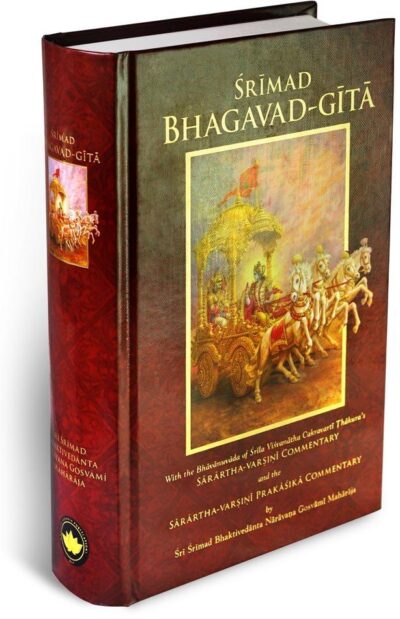
-Aditya Bharadwaj Khandavalli
The first CDS of Bharat Late Gen. Bipin Rawat used to have two copies of the sacred Bhagavadgita in his office, one on his table and the other in the shelf behind him. A journalist once observed this and found out from Gen Rawat that he kept the sacred Gita in his office, so that all decisions he takes should reflect the Dharmic cause and national interest. Shrimad Bhagavadgita hence is an essential text in Hindu philosophy and culture. It is considered as the Vedanta, which inherently means that the Bhagawadgita contains the essence of the Vedas, the Upanishads and the Darshanas. The Gita has 18 chapters and 700 slokas out of which 574 were by Sri Krishna, 84 by Arjuna and 41 by Sanjaya and 1 by Dhritarashtra. It has both a vivid sense of abstraction and a practical approach embedded in it, and this integration of two polar traits is one of the specialities of the text. It begins with the sloka of `Dharma Kshetre Kurukshetre’, and this phrase of Dharma is iterated and reiterated throughout. Syntactically Dhrama means the one which is applicable (Dharayate Iti Dharmah). Thus, the Gita encircles the thought of living and sense of life (Sanskriti and Sanskara). The level of the text is such that the most abstract thought was put forth and described, such as the Vishwaroopa.
Oppenheimer, who was the architect of atom bomb after its explosion, couldn’t find any other words except the Gita to describe its fatality and effect. Not just Oppenheimer, a great number of stalwarts have referred to the Gita and taken inspiration from it, whether Swami Vivekananda who in his first speech at World Parliament of Religions at Chicago in 1893 stated, “My dear brothers and sisters of America”, and continues “I come from the land of Gita…”; or Bhagat singh who dedicated his life for the national cause just by revising the words of “Karmanye VadhiKaraste ma Phaleshu Kadhachana”; or Shri Aurobindo who expressed his thoughts and experiences of Gita in his `Essays On Gita’ in which he says “Gita is neither a religious text nor a regulatory text; in my view it is an universal text”; or Lokmanya Balagangadhara Tilak who wrote about his perspective of Gita in his book ‘The Gita Rahasya’.
Gita is a source of inspiration and provides guidance of life for all ages, as Gita itself took birth out of anguish and quest. Arjuna was firm that he would retreat from the battle, that’s when Sri Krishna asks the reasons and elucidates all the concepts in totality. The context is not a routine situation, and it relates itself to the whole of humanity to pursue the goal and stand undeterred. Gita’s spirit and rigour inspired millions, whether in the national struggle towards Swarajya or in the path of building a Surajya. Rani of Jhansi, Laxmibai raged into the battle revisiting the sloka of “Hatova Prapyase Swargam Jitvava Bhojyase Mahiim”; the situation was dire and she found the necessary inspiration from Gita to charge ahead and swing the battle through. Bhagawad Gita is considered a religious text and at times is equated to the Quran and the Bible, but it is neither a commandment nor a gospel, it is the experience of life and nature, as well as the realization of pursuing one’s objectives in life. So, when Sri Krishna states “Paritranaya Sadhunaam Vinasaya Cha Dushkrutam” as his objective, it means it needs to be followed and that thought should reverberate in all for Dharmic living and culture. It directs the being that a sense of acceptance is essential to learn when it states “Sraddhavan labhate Gnanam” and that knowledge can only be synthesized with the help of practice and self-effort- Svadhyay abhyasanam Chaiva Vangmayam Tava Uchyate”. The Gita gives a direction to follow the natural flow of life and culture, rather than converting one’s stance from one culture to other, giving the excuse of errors as the reason “Svadharme Vigunam Shreyah”. This way it gives a path of thought to achieve stability and evolve as a being into higher planes of life and culture through character. The Gita speaks of numerous aspects and situations of life in a tone of understanding, summation and a practical perspective, this became possible as it was born amidst the warzone of Kurukshetra. While war is all about action, Gita speaks volumes on it, it specifies some actions while barring some others. It describes the state of mind in tranquillity which is undeterred of the results but focused on the process. It is not that the results aren’t expected or yielded; it is just that the mind should have faith in itself and nature while performing any action. Such a state of mind is desired in beings for achieving the expected objectives. It stresses on the process of action than the result when it says “Yogah Karmasu Kausalam”. Thus, the Gita is surely an encyclopaedia and much more in terms of life and its sculpture. Gita is relevant for all ages – past, present and future, as it carries the trait of “Nitya Nutana and Chira Puratana”. May we derive Gita’s relevance in our lives to lead a Dharmic life and build the nation with the fundamentals of culture and existence.
||Yatho Dharma Tatho Jaya||














